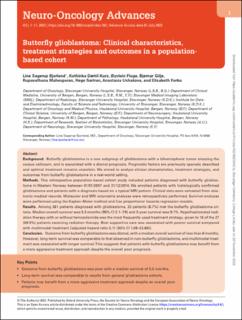| dc.contributor.author | Bjorland, Line | |
| dc.contributor.author | Kurz, Kathinka Dæhli | |
| dc.contributor.author | Fluge, Øystein | |
| dc.contributor.author | Gilje, Bjørnar | |
| dc.contributor.author | Mahesparan, Rupavathana | |
| dc.contributor.author | Sætran, Hege Aase | |
| dc.contributor.author | Ushakova, Anastasia | |
| dc.contributor.author | Farbu, Elisabeth | |
| dc.date.accessioned | 2022-12-12T10:06:56Z | |
| dc.date.available | 2022-12-12T10:06:56Z | |
| dc.date.created | 2022-11-25T12:40:50Z | |
| dc.date.issued | 2022 | |
| dc.identifier.issn | 2632-2498 | |
| dc.identifier.uri | https://hdl.handle.net/11250/3037196 | |
| dc.description.abstract | Background
Butterfly glioblastoma is a rare subgroup of glioblastoma with a bihemispheric tumor crossing the corpus callosum, and is associated with a dismal prognosis. Prognostic factors are previously sparsely described and optimal treatment remains uncertain. We aimed to analyze clinical characteristics, treatment strategies, and outcomes from butterfly glioblastoma in a real-world setting.
Methods
This retrospective population-based cohort study included patients diagnosed with butterfly glioblastoma in Western Norway between 01/01/2007 and 31/12/2014. We enrolled patients with histologically confirmed glioblastoma and patients with a diagnosis based on a typical MRI pattern. Clinical data were extracted from electronic medical records. Molecular and MRI volumetric analyses were retrospectively performed. Survival analyses were performed using the Kaplan–Meier method and Cox proportional hazards regression models.
Results
Among 381 patients diagnosed with glioblastoma, 33 patients (8.7%) met the butterfly glioblastoma criteria. Median overall survival was 5.5 months (95% CI 3.1–7.9) and 3-year survival was 9.1%. Hypofractionated radiation therapy with or without temozolomide was the most frequently used treatment strategy, given to 16 of the 27 (59.3%) patients receiving radiation therapy. Best supportive care was associated with poorer survival compared with multimodal treatment [adjusted hazard ratio 5.11 (95% CI 1.09–23.89)].
Conclusion
Outcome from butterfly glioblastoma was dismal, with a median overall survival of less than 6 months. However, long-term survival was comparable to that observed in non-butterfly glioblastoma, and multimodal treatment was associated with longer survival. This suggests that patients with butterfly glioblastoma may benefit from a more aggressive treatment approach despite the overall poor prognosis. | en_US |
| dc.language.iso | eng | en_US |
| dc.publisher | Oxford University Press | en_US |
| dc.rights | Navngivelse 4.0 Internasjonal | * |
| dc.rights.uri | http://creativecommons.org/licenses/by/4.0/deed.no | * |
| dc.title | Butterfly glioblastoma: Clinical characteristics, treatment strategies and outcomes in a population-based cohort | en_US |
| dc.type | Journal article | en_US |
| dc.type | Peer reviewed | en_US |
| dc.description.version | publishedVersion | en_US |
| dc.rights.holder | Copyright 2022 The Author(s) | en_US |
| dc.source.articlenumber | vdac102 | en_US |
| cristin.ispublished | true | |
| cristin.fulltext | original | |
| cristin.qualitycode | 1 | |
| dc.identifier.doi | 10.1093/noajnl/vdac102 | |
| dc.identifier.cristin | 2080995 | |
| dc.source.journal | Neuro-Oncology Advances (NOA) | en_US |
| dc.identifier.citation | Neuro-Oncology Advances (NOA). 2022, 4 (1), vdac102. | en_US |
| dc.source.volume | 4 | en_US |
| dc.source.issue | 1 | en_US |

